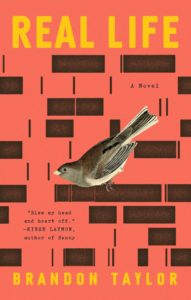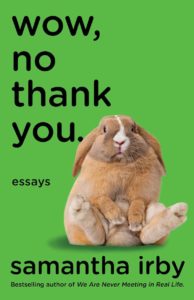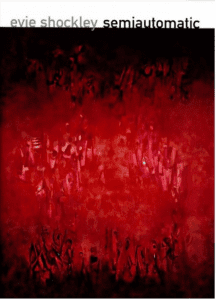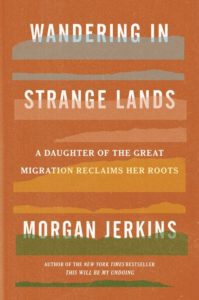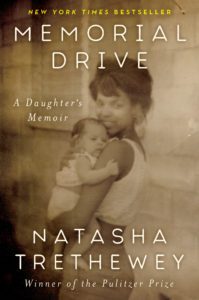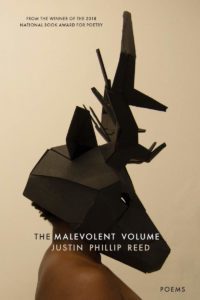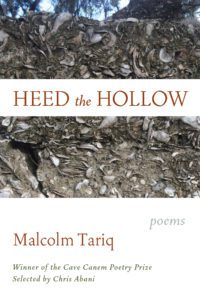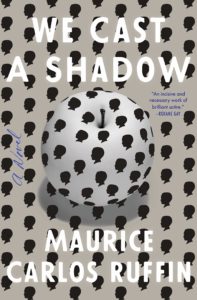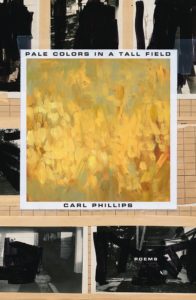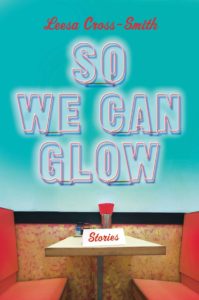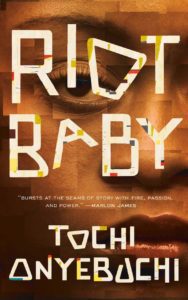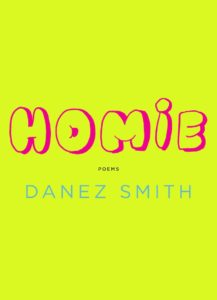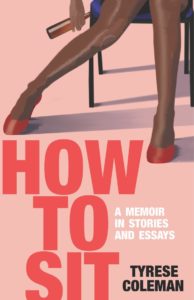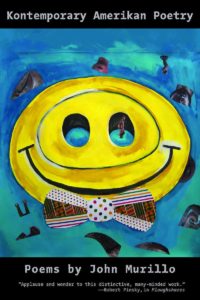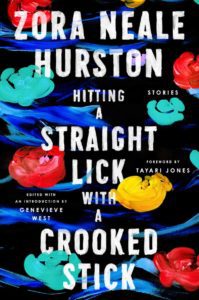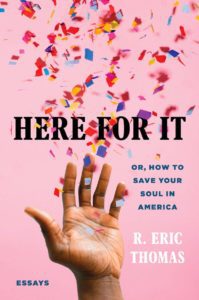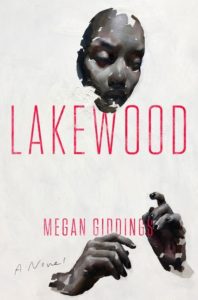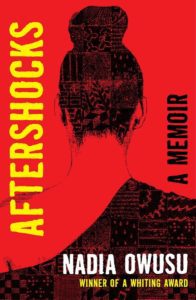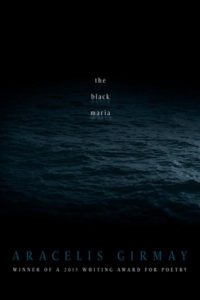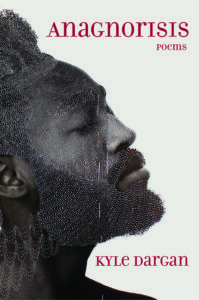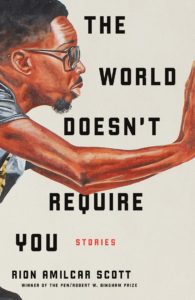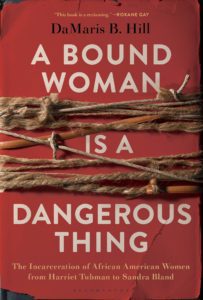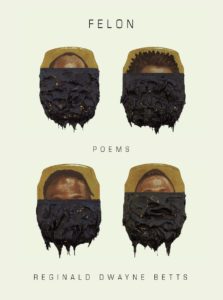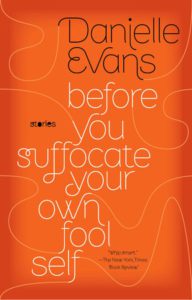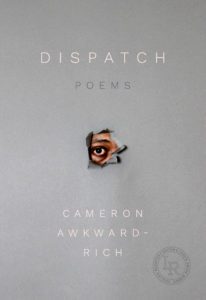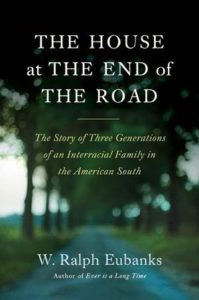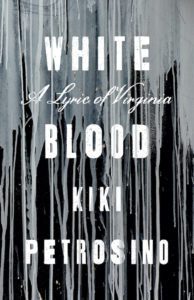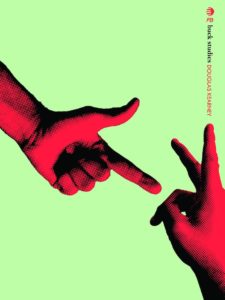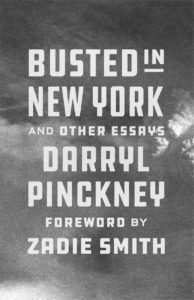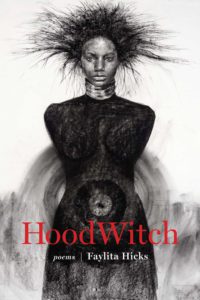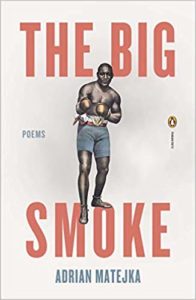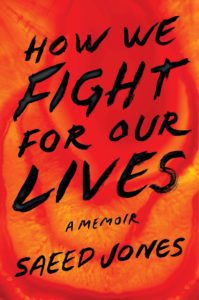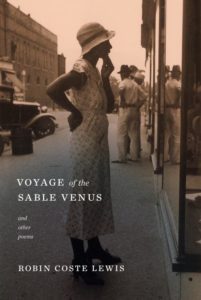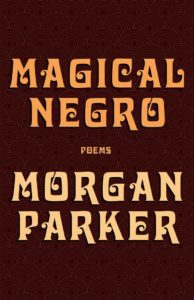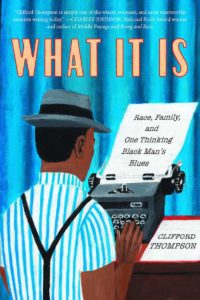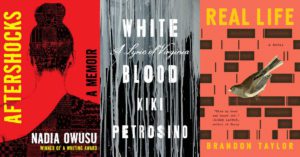
It’s Black History Month, and while The Rumpus celebrates writing by Black artists year-round, we think it is especially important to share a list of work written exclusively by Black writers this month. We asked our editors to share some of their favorite writing that speaks to Black history past, present, and future—and we’re especially excited about how much work is forthcoming this year from Black writers we love and admire.
Black artists have been creating art for centuries across a broad spectrum of mediums and styles—the below list highlights just a fraction of that work, and we are grateful to share it with you.
***
Real Life by Brandon Taylor
A novel of rare emotional power that excavates the social intricacies of a late-summer weekend—and a lifetime of buried pain. Almost everything about Wallace, an introverted African-American transplant from Alabama, is at odds with the lakeside Midwestern university town where he is working toward a biochemistry degree. For reasons of self-preservation, Wallace has enforced a wary distance even within his own circle of friends—some dating each other, some dating women, some feigning straightness. But a series of confrontations with colleagues, and an unexpected encounter with a young straight man, conspire to fracture his defenses, while revealing hidden currents of resentment and desire that threaten the equilibrium of their community.
Wow, No Thank You by Samantha Irby
Irby is forty, and increasingly uncomfortable in her own skin despite what Inspirational Instagram Infographics have promised her. She has left her job as a receptionist at a veterinary clinic, has published successful books and has been friendzoned by Hollywood, left Chicago, and moved into a house with a garden that requires repairs and know-how with her wife in a blue town in the middle of a red state where she now hosts book clubs and makes mason jar salads. This is the bourgeois life of a Hallmark Channel dream. She goes on bad dates with new friends, spends weeks in Los Angeles taking meetings with “TV executives slash amateur astrologers” while being a “cheese fry-eating slightly damp Midwest person,” “with neck pain and no cartilage in [her] knees,” who still hides past-due bills under her pillow.
Semiautomatic by Evie Shockley
Art can’t shield our bodies or stabilize the earth’s climate, but Evie Shockley’s semiautomatic insists that it can feed the spirit and reawaken the imagination. The volume responds primarily to the twenty-first century’s inescapable evidence of the terms of black life—not so much new as newly visible. The poems trace a whole web of connections between the kinds of violence that affect people across the racial, ethnic, gender, class, sexual, national, and linguistic boundaries that do and do not divide us. How do we protect our humanity, our ability to feel deeply and think freely, in the face of a seemingly endless onslaught of physical, social, and environmental abuses? Where do we find language to describe, process, and check the attacks and injuries we see and suffer? What actions can break us out of the soul-numbing cycle of emotions, moving through outrage, mourning, and despair, again and again? In poems that span fragment to narrative and quiz to constraint, from procedure to prose and sequence to song, semiautomatic culls past and present for guides to a hoped-for future.
Wandering in Strange Lands by Morgan Jerkins
Between 1916 and 1970, six million black Americans left their rural homes in the South for jobs in cities in the North, West, and Midwest in a movement known as The Great Migration. But while this event transformed the complexion of America and provided black people with new economic opportunities, it also disconnected them from their roots, their land, and their sense of identity, argues Morgan Jerkins. In this fascinating and deeply personal exploration, she recreates her ancestors’ journeys across America, following the migratory routes they took from Georgia and South Carolina to Louisiana, Oklahoma, and California. Following in their footsteps, Jerkins seeks to understand not only her own past, but the lineage of an entire group of people who have been displaced, disenfranchised, and disrespected throughout our history. Through interviews, photos, and hundreds of pages of transcription, Jerkins braids the loose threads of her family’s oral histories, which she was able to trace back 300 years, with the insights and recollections of black people she met along the way–the tissue of black myths, customs, and blood that connect the bones of American history.
Memorial Drive: A Daughter’s Memoir by Natasha Trethewey
At age nineteen, Natasha Trethewey had her world turned upside down when her former stepfather shot and killed her mother. Grieving and still new to adulthood, she confronted the twin pulls of life and death in the aftermath of unimaginable trauma and now explores the way this experience lastingly shaped the artist she became. With penetrating insight and a searing voice that moves from the wrenching to the elegiac, Trethewey explores this profound experience of pain, loss, and grief as an entry point into understanding the tragic course of her mother’s life and the way her own life has been shaped by a legacy of fierce love and resilience. Moving through her mother’s history in the deeply segregated South and through her own girlhood as a “child of miscegenation” in Mississippi, Trethewey plumbs her sense of dislocation and displacement in the lead-up to the harrowing crime that took place on Memorial Drive in Atlanta in 1985.
The Malevolent Volume by Justin Phillip Reed
Subverting celebrated classics of poetry and mythology and examining horrors from contemporary film and cultural fact, Justin Phillip Reed engages darkness as an aesthetic to conjure the revenant animus that lurks beneath the exploited civilities of marginalized people. In these poems, Reed finds agency in the other-than-human identities assigned to those assaulted by savageries of the state. In doing so, he summons a retaliatory, counter-violent Black spirit to revolt and to inhabit the revolting.
Heed the Hollow by Malcolm Tariq
Heed the Hollow introduces the work of Malcolm Tariq, whose poems explore the concept of “the bottom” across blackness, sexuality, and the American South. These lyrics of queer desire meet the voices of enslaved ancestors to reckon with a lineage of trauma that manifests as silence, pain, and haunting memories, but also as want and love. In bops, lyrics, and erasures, Heed the Hollowtells of a heritage anchored to the landscape of the coastal South, to seawalls shaped by forced labor, and to the people “marked into the bottom / of history where then now / we find no shadow of life.” From that shadow, the voices in these poems make their own brightness, reclaiming their histories from a language that evolved to exclude them.
We Cast a Shadow by Maurice Carlos Ruffin
“You can be beautiful, even more beautiful than before.” This is the seductive promise of Dr. Nzinga’s clinic, where anyone can get their lips thinned, their skin bleached, and their nose narrowed. A complete demelanization will liberate you from the confines of being born in a black body—if you can afford it. In this near-future Southern city plagued by fenced-in ghettos and police violence, more and more residents are turning to this experimental medical procedure. Like any father, our narrator just wants the best for his son, Nigel, a biracial boy whose black birthmark is getting bigger by the day. The darker Nigel becomes, the more frightened his father feels. But how far will he go to protect his son? And will he destroy his family in the process?
Pale Colors in a Tall Field by Carl Phillips
Carl Phillips’s new poetry collection, Pale Colors in a Tall Field, is a meditation on the intimacies of thought and body as forms of resistance. The poems are both timeless and timely, asking how we can ever truly know ourselves in the face of our own remembering and inevitable forgetting. Here, the poems metaphorically argue that memory is made up of various colors, with those most prominent moments in a life seeming more vivid, though the paler colors are never truly forgotten. The poems in Pale Colors in a Tall Field approach their points of view kaleidoscopically, enacting the self’s multiplicity and the difficult shifts required as our lives, in turn, shift.
So We Can Glow by Leesa Cross-Smith
From Kentucky to the California desert, these forty-two short stories expose the glossy and matte hearts of girls and women in moments of obsessive desire and fantasy, wildness and bad behavior, brokenness and fearlessness, and more.Teenage girls sneak out on a summer night to meet their boyfriends by the train tracks. A woman escapes suffocating grief through a vivid fantasy life. Members of a cult form an unsettling chorus as they extol their passion for the same man. A love story begins over cabbages in a grocery store. A laundress’ life is consumed by obsession for a famous baseball player. Two high school friends kiss all night and binge-watch Winona Ryder movies after the death of a sister. The stories in So We Can Glow—some long, some gone in a flash, some told over text and email—take the wild hearts of girls and women and hold them up so they can catch the light.
Riot Baby by Tochi Onyebuchi
Ella has a Thing. She sees a classmate grow up to become a caring nurse. A neighbor’s son murdered in a drive-by shooting. Things that haven’t happened yet. Kev, born while Los Angeles burned around them, wants to protect his sister from a power that could destroy her. But when Kev is incarcerated, Ella must decide what it means to watch her brother suffer while holding the ability to wreck cities in her hands. Rooted in the hope that can live in anger, Riot Baby is as much an intimate family story as a global dystopian narrative. It burns fearlessly toward revolution and has quietly devastating things to say about love, fury, and the black American experience. Ella and Kev are both shockingly human and immeasurably powerful. Their childhoods are defined and destroyed by racism. Their futures might alter the world.
Homie by Danez Smith
Homie is Danez Smith’s magnificent anthem about the saving grace of friendship. Rooted in the loss of one of Smith’s close friends, this book comes out of the search for joy and intimacy within a nation where both can seem scarce and getting scarcer. In poems of rare power and generosity, Smith acknowledges that in a country overrun by violence, xenophobia, and disparity, and in a body defined by race, queerness, and diagnosis, it can be hard to survive, even harder to remember reasons for living. But then the phone lights up, or a shout comes up to the window, and family―blood and chosen―arrives with just the right food and some redemption. Part friendship diary, part bright elegy, part war cry, Homie is the exuberant new book written for Danez and for Danez’s friends and for you and for yours.
How to Sit: A Memoir in Stories and Essays by Tyrese L. Coleman
How to Sit, when viewed in its entirety, plays with the line between fiction and nonfiction as it explores adolescence, identity, grief, and the transition between girlhood and womanhood for a young black woman seeking to ground herself when all she wants is to pretend her world is fantasy.
Kontemporary Amerikan Poetry by John Murillo
John Murillo’s second book is a reflective look at the legacy of institutional, accepted violence against Blacks and Latinos and the personal and societal wreckage wrought by long histories of subjugation. A sparrow trapped in a car window evokes a mother battered by a father’s fists; a workout at an iron gym recalls a long-ago mentor who pushed the speaker “to become something unbreakable.” At the heart of the book is a sonnet crown triggered by the shooting deaths of three Brooklyn men that becomes an extended meditation on the history of racial injustice and the notion of payback as a form of justice.
Hitting a Straight Lick with a Crooked Stick: Stories from the Harlem Renaissance by Zora Neale Hurston
Hitting a Straight Lick with a Crooked Stick is an outstanding collection of stories about love and migration, gender and class, racism and sexism that proudly reflect African American folk culture. Brought together for the first time in one volume, they include eight of Hurston’s “lost” Harlem stories, which were found in forgotten periodicals and archives. These stories challenge conceptions of Hurston as an author of rural fiction and include gems that flash with her biting, satiric humor, as well as more serious tales reflective of the cultural currents of Hurston’s world. All are timeless classics that enrich our understanding and appreciation of this exceptional writer’s voice and her contributions to America’s literary traditions.
Here for It: Or, How to Save Your Soul in America by R. Eric Thomas
In essays by turns hysterical and heartfelt, Eric redefines what it means to be an “other” through the lens of his own life experience. He explores the two worlds of his childhood: the barren urban landscape where his parents’ house was an anomalous bright spot, and the verdant school they sent him to in white suburbia. He writes about struggling to reconcile his Christian identity with his sexuality, the exhaustion of code-switching in college, accidentally getting famous on the internet (for the wrong reason), and the surreal experience of covering the 2016 election, and the seismic changes that came thereafter. Ultimately, Eric seeks the answer to these ever more relevant questions: Is the future worth it? Why do we bother when everything seems to be getting worse? As the world continues to shift in unpredictable ways, Eric finds the answers to these questions by re-envisioning what “normal” means and in the powerful alchemy that occurs when you at last place yourself at the center of your own story.
Lakewood by Megan Giddings
When Lena Johnson’s beloved grandmother dies, and the full extent of the family debt is revealed, the black millennial drops out of college to support her family and takes a job in the mysterious and remote town of Lakewood, Michigan. On paper, her new job is too good to be true. High paying. No out of pocket medical expenses. A free place to live. All Lena has to do is participate in a secret program—and lie to her friends and family about the research being done in Lakewood. An eye drop that makes brown eyes blue, a medication that could be a cure for dementia, golden pills promised to make all bad thoughts go away. The discoveries made in Lakewood, Lena is told, will change the world—but the consequences for the subjects involved could be devastating. As the truths of the program reveal themselves, Lena learns how much she’s willing to sacrifice for the sake of her family.
Aftershocks: A Memoir by Nadia Owusu
Nadia Owusu grew up all over the world—from Rome and London to Dar-es-Salaam and Kampala. When her mother abandoned her when she was two years old, the rejection caused Nadia to be confused about her identity. Even after her father died when she was thirteen and she was raised by her stepmother, she was unable to come to terms with who she was since she still felt motherless and alone. When Nadia went to university in America when she was eighteen she still felt as if she had so many competing personas that she couldn’t keep track of them all without cracking under the pressure of trying to hold herself together. A powerful coming-of-age story that explores timely and universal themes of identity, Aftershocks follows Nadia’s life as she hauls herself out of the wreckage and begins to understand that the only ground firm enough to count on is the one she writes into existence.
the black maria by Aracelis Girmay
Taking its name from the moon’s dark plains, misidentified as seas by early astronomers, the black maria investigates African diasporic histories, the consequences of racism within American culture, and the question of human identity. Central to this project is a desire to recognize the lives of Eritrean refugees who have been made invisible by years of immigration crisis, refugee status, exile, and resulting statelessness.
Anagnorisis by Kyle Dargan
Dargan is both enthralled and provoked, having witnessed—on a digital loop running in the background of Barack Obama’s unlikely presidency—the rampant state-sanctioned murder of fellow black Americans. He is pushed toward the same recognition articulated by James Baldwin decades earlier: that a black American may never be considered an equal in citizenship or humanity. This recognition—the moment at which a tragic hero realizes the true nature of his own character, condition, or relationship with an antagonistic entity—is what Aristotle called anagnorisis. At a time when US politics are heavily invested in the purported vulnerability of working-class and rural white Americans, these poems allow readers to examine themselves and America through the eyes of those who have been burned for centuries.
The World Doesn’t Require You by Rion Amilcar Scott
Established by the leaders of the country’s only successful slave revolt in the mid-nineteenth century, Cross River still evokes the fierce rhythms of its founding. Among its residents―wildly spanning decades, perspectives, and species―are David Sherman, a struggling musician who just happens to be God’s last son; Tyrone, a ruthless PhD candidate, whose dissertation about a childhood game ignites mayhem in the neighboring, once-segregated town of Port Yooga; and Jim, an all-too-obedient robot who serves his Master. As the book builds to its finish with “Special Topics in Loneliness Studies,” a fully-realized novella, two unhinged professors grapple with hugely different ambitions, and the reader comes to appreciate the intricacy of the world Scott has created―one where fantasy and reality are eternally at war.
A Bound Woman Is a Dangerous Thing: The Incarceration of African American Women from Harriet Tubman to Sandra Bland by DaMaris B. Hill
In A Bound Woman Is a Dangerous Thing, Hill presents bitter, unflinching history that artfully captures the personas of these captivating, bound yet unbridled African-American women. Hill’s passionate odes to Zora Neale Hurston, Lucille Clifton, Fannie Lou Hamer, Grace Jones, Eartha Kitt, and others also celebrate the modern-day inheritors of their load and light, binding history, author, and reader in an essential legacy of struggle.
Felon by Reginald Dwayne Betts
Felon tells the story of the effects of incarceration in fierce, dazzling poems—canvassing a wide range of emotions and experiences through homelessness, underemployment, love, drug abuse, domestic violence, fatherhood, and grace—and, in doing so, creates a travelogue for an imagined life. Reginald Dwayne Betts confronts the funk of post-incarceration existence and examines prison not as a static space, but as a force that enacts pressure throughout a person’s life. The poems move between traditional and newfound forms with power and agility—from revolutionary found poems created by redacting court documents to the astonishing crown of sonnets that serves as the volume’s radiant conclusion. Drawing inspiration from lawsuits filed on behalf of the incarcerated, the redaction poems focus on the ways we exploit and erase the poor and imprisoned from public consciousness. Traditionally, redaction erases what is top secret; in Felon, Betts redacts what is superfluous, bringing into focus the profound failures of the criminal justice system and the inadequacy of the labels it generates.
Before You Suffocate Your Own Fool Self by Danielle Evans
In “Harvest,” a college student’s unplanned pregnancy forces her to confront her own feelings of inadequacy in comparison to her white classmates. In “Jellyfish,” a father’s misguided attempt to rescue a gift for his grown daughter from an apartment collapse magnifies all he doesn’t know about her. And in “Snakes,” the mixed-race daughter of intellectuals recounts the disastrous summer she spent with her white grandmother and cousin, a summer that has unforeseen repercussions in the present. Striking in their emotional immediacy, the stories in Before You Suffocate Your Own Fool Self are based in a world where inequality is reality but where the insecurities of adolescence and young adulthood, and the tensions within family and the community, are sometimes the biggest complicating forces in one’s sense of identity and the choices one makes.
Dispatch by Cameron Awkward-Rich
Set against the media environment that saturates even our most intimate spaces, Dispatch attends to, revises, and thinks adjacent to the news of racial/gendered violence in the US, from the nineteenth century to the present day. These poems ask: What kind of revisions will make this a world/a story that is concerned with my people’s flourishing? How ought I pay attention, how to register perpetual bad news without letting it fatally intrude? Cameron Awkward-Rich is among the most bracing voices to emerge in recent years, a dazzling exemplar of poetry’s (and humanity’s) possibilities.
The House at the End of the Road: The Story of Three Generations of an Interracial Family in the American South by W. Ralph Eubanks
A story of one family’s love and courage in the Jim Crow-era Deep South In defiance of his middle-class landowning family, a young white man named James Morgan Richardson married a light-skinned black woman, Edna Howell. It was 1914 in south Alabama. Together they eventually built a house at the dead end of a road in a rural black community. If you came there to do the Richardson family harm, you faced Jim Richardson’s rule of justice, represented by a double-barreled shotgun. And at the end of the road, there was only one way out. Through interviews and oral history collected from both sides of the Richardson family’s racial divide, as well as archival research, The House at the End of the Road probes into the core of the issue of race in early twentieth-century America. At the same time, it takes the lessons of the past and places them under the scrutiny of a contemporary world adjusted to DNA ancestry testing, a more flexible sense of racial and ethnic identity, and a tolerance and acceptance of the racial ambiguity that laws prohibiting Jim and Edna Richardson’s marriage sought to eliminate. Jim and Edna Richardson were Ralph Eubanks’s grandparents. Now, decades after interracial marriage became legal, Eubanks takes readers on a journey back to his grandparents’ house at the end of the road where he reconstructs their life and times and seeks lessons for America’s multiracial future.
White Blood: A Lyric of Virginia by Kiki Petrosino
In her fourth full-length book, Kiki Petrosino turns her gaze to Virginia, where she digs into her genealogical and intellectual roots, while contemplating the knotty legacies of slavery and discrimination in the Upper South. From a stunning double crown sonnet, to erasure poetry contained within DNA testing results, the poems in this collection are as wide-ranging in form as they are bountiful in wordplay and truth. Speaking to history, loss, and injustice with wisdom, innovation, and a scientific determination to find the poetic truth, White Blood plants Petrosino’s name ever more firmly in the contemporary canon.
Buck Studies by Douglas Kearney
Dynamic poet, performer, librettist, and professor Douglas Kearney’s works speak to those who are listening to what our living, material language has to say about race and history. At the hub of Buck Studies is a long mash-up of the stories of Herakles, the Greek bad-man, and that of Stagger Lee, the black bad-man. “Stagger Put Work In” examines the Twelve Labors Herakles performed to atone for murdering his family through Stagger Lee’s murder of black man Billy Lyons. What is enacted by this appropriation is an exhaustion of forms—gangsta rap and its antecedent, the murder ballad.
Busted in New York and Other Essays by Darryl Pinckney
In these twenty-five essays, Darryl Pinckney has given us a view of our recent racial history that blends the social and the personal and wonders how we arrived at our current moment. These are capacious essays whose topics range from the grassroots of protest in Ferguson, Missouri, to the eighteenth-century Guadeloupian composer Joseph Bologne, from an unsparing portrait of Louis Farrakhan to the enduring legacy of James Baldwin, the unexpected story of black people experiencing Russia, Barry Jenkins’s Moonlight, and the painter Kara Walker. The essays themselves are a kind of record, many of them written in real-time, as Pinckney witnesses the Million Man March, feels and experiences the highs and lows of Obama’s first presidential campaign, explores the literary black diaspora, and reflects on the surprising and severe lesson he learned firsthand about the changing urban fabric of New York.
HoodWitch by Faylita Hicks
In this collection about resilience, Hicks speaks about giving her child up for adoption, mourning the death of her fiancé, and embracing the nonbinary femme body—persevering in the face of medical malpractice, domestic abuse, and police violence. Exploring the intersections of Christianity, modern mysticism, and Afrofuturism in a sometimes urban, sometimes natural setting, Hicks finds a place where “everyone everywhere is hands in the air,” where “you know they gonna push & pull it together. / Just like they learned to.” It is a place of natural magick—where someone like Hicks can have more than one name: where they can be both dead and alive, both a mortal and a god.
The Big Smoke by Adrian Matejka
The legendary Jack Johnson (1878-1946) was a true American creation. The child of emancipated slaves, he overcame the violent segregationism of Jim Crow, challenging white boxers—and white America—to become the first African-American heavyweight world champion. The Big Smoke, Adrian Matejka’s third work of poetry, follows the fighter’s journey from poverty to the most coveted title in sports through the multi-layered voices of Johnson and the white women he brazenly loved. Matejka’s book is part historic reclamation and part interrogation of Johnson’s complicated legacy, one that often misremembers the magnetic man behind the myth.
How We Fight for Our Lives by Saeed Jones
Haunted and haunting, Jones’s memoir tells the story of a young, black, gay man from the South as he fights to carve out a place for himself, within his family, within his country, within his own hopes, desires, and fears. Through a series of vignettes that chart a course across the American landscape, Jones draws readers into his boyhood and adolescence—into tumultuous relationships with his mother and grandmother, into passing flings with lovers, friends and strangers. Each piece builds into a larger examination of race and queerness, power and vulnerability, love and grief: a portrait of what we all do for one another—and to one another—as we fight to become ourselves.
Voyage of the Sable Venus by Robin Coste Lewis
Robin Coste Lewis’s electrifying collection is a triptych that begins and ends with lyric poems meditating on the roles desire and race play in the construction of the self. In the center of the collection is the title poem, “Voyage of the Sable Venus,” an amazing narrative made up entirely of titles of artworks from ancient times to the present—titles that feature or in some way comment on the black female figure in Western art. Bracketed by Lewis’s own autobiographical poems, “Voyage” is a tender and shocking meditation on the fragmentary mysteries of stereotype, juxtaposing our names for things with what we actually see and know. A new understanding of biography and the self, this collection questions just where, historically, do ideas about the black female figure truly begin—five hundred years ago, five thousand, or even longer? And what role did art play in this ancient, often heinous story?
Magical Negro by Morgan Parker
Magical Negro is an archive of black everydayness, a catalog of contemporary folk heroes, an ethnography of ancestral grief, and an inventory of figureheads, idioms, and customs. These American poems are both elegy and jive, joke and declaration, songs of congregation and self-conception. They connect themes of loneliness, displacement, grief, ancestral trauma, and objectification, while exploring and troubling tropes and stereotypes of Black Americans. Focused primarily on depictions of black womanhood alongside personal narratives, the collection tackles interior and exterior politics―of both the body and society, of both the individual and the collective experience.
What It Is: Race, Family, and One Thinking Black Man’s Blues by Clifford Thompson
Thompson was raised to believe in treating every person of every color as an individual, and he decided as a young man that America, despite its history of racial oppression, was his home as much as anyone else’s. As a middle-aged, happily married father of biracial children, Thompson finds himself questioning his most deeply held convictions when the race-baiting Donald Trump ascends to the presidency—elected by whites, whom Thompson had refused to judge as a group, and who make up the majority in this country Thompson had called his own. In the grip of contradictory emotions, Thompson turns for guidance to the wisdom of writers he admires while knowing that the answers to his questions about America ultimately lie in America itself. Through interviews with a small but varied group of Americans he hears sharply divergent opinions about what is happening in the country while trying to find his own answers—conclusions based not on conventional wisdom or on what he would like to believe, but on what he sees.

